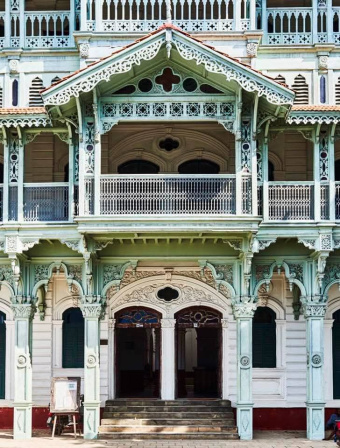Khoja Nasser Noormohamed Dispensary
Contents
Preface
This article, contributed by Abdulrazak Fazal, offers a compelling narrative of the Khoja Nasser Noormohamed Dispensary—an enduring symbol of the Khoja community’s charitable legacy in Zanzibar. Originally established in memory of Nasser Noormohamed’s son, the dispensary served as a vital healthcare centre for both Khoja Ithna’ashri and Ismaili communities. Through the author’s personal recollections and historical insight, the article highlights not only the building’s architectural and cultural significance but also the lives it touched across generations.
Historical and Architectural Significance
Alighting from the ship and landing on Zanzibar, there emerges the imposing dispensary building and the past comes flooding back. In particular for me, the building evokes a poignant memory of going there every Sunday morning to visit my aunt who was bedridden and resided on its ground floor.
One of Zanzibar's main attractions in Stone Town is this old Khoja dispensary, now transformed into a ‘Cultural Centre’. To us old timers, it will always remain the ‘Khoja Nasser Noormohamed Dispensary’. It was a huge complex and a considerable portion (a small part of its ground floor and its two storeys) was allotted to tenants, the rental proceeds from which were used for running the dispensary. The two floors were occupied by Husain Raheem, Jaffer Raheem, Fazal Nasser Mawji and Yusuf Hasam Nasser. Incidentally my aunt, Mrs. Fatmabai Jaffer Ali Dungersi (Fatuma Dada), resided on the ground floor. The ‘Cultural Centre’ photograph is very much in vogue today and reproduced in almost every tourist booklet, brochure or guide.
The building, located in one corner at the far end of a Malindi lane, and on the Forodhani/harbour highway, was built according to the historian Riadh Al Busaidi by Sayyid Abdalla bin Jaad bin Mubarak Al Busaidi. Later, it was bought and extended by Khoja Tharia Topan (a prominent Khoja Ismaili), who died before its completion in 1899. The Trustees of Tharia Topan parted with its ownership in 1901 by selling it to the Trustees of Khoja Nasser Noormohamed Kasmani who earlier had been converted to the Ithnashri Sect but had also passed away before the deal was finalised. The building with its open roof terrace and ornate balconies and facade stood majestically in a row of other architectural masterpieces like the Sultan’s Palace (now People's Palace) and Beit Al Ajaib along Forodhani (the Sea Front). It was believed that the building was specifically built to commemorate Queen Victoria’s Golden Jubilee.
Sadly, Nasser Noormohamed’s young son had died of a severe illness, and in his memory, this building was donated as a dispensary to the Khojas. The building thus came to be known as ‘Khoja Nasser Noormohamed Dispensary’ and both the Khoja Sects, Ithnashris as well as Ismailis, had access to it. However, Nasser Noormohamed, being an Ithnashri, the dispensary was under the trusteeship of Kuwwat and Hujjat Jamaats and patronised by the Ithnashries who frequented it for treatment. Those who had served there at one time or another were Doctors Gulamhusain, Awara, Raza Khakoo, Oza and some others. Even Doctors Goradia, Mehta and Patel had worked there before establishing their own clinics.
Dispensary Administration
The dispensary’s administration is worthy of mention. Mohamedali Merali Rhemtulla and the bespectacled, pipe smoking Alimohamed Ahmed attentively peered through the thick register to check the patient’s name and then delivered him his card, selected from a pile of cards along with the number tag that had to be strictly adhered to. The doctor very rarely injected. There was no testing of blood or monitoring of blood pressure. The common prescription was ‘puri’ (powder) and white and coloured medicine. The compounders Esmail Jaffer ‘Popo’ (a Khoja Ismaili), Husain (Madawa) and Fida Mammu Molu grinded the tablets into ‘puri’, prepared the mixtures into medicine and labelled the doses on the bottle. The fever vanished in no time. They even handed out a pack of ‘malam’ (ointment) if prescribed. The highly competent Hassani (the male nurse) had his small room at the far end of the dispensary. He applied yellow or red medicine on the cut or boils and then bandaged it up with his unique way of tightening the knot. The bandage had to be changed on a regular basis when he vigorously cleaned the wound.
Philanthropy & Charitable Legacy
Nasser Noormohamed was an extremely wealthy person and highly charitable. He was said to own a large number of houses in Zanzibar stone town. In addition to this he had his ‘shambas’ (countryside resorts) and a ‘Pedhi’ (company) where his business dealings were executed. Khoja Hassam Alibhai was said to be one of Nasser Noormohamed’s close confidants. Nasser Noormohamed also had properties in Madagascar and Jamnagar. On my visit to Jamnagar in the 1960s I was taken to the Khoja Boarding House that had its wall adorned with huge portraits of Nasser Noormohamed, Jetha Ghokal, Dawood Haji Nasser and Jaffer Mohamed Sheriff. He had even built the ‘musafirkhana’ in Karbala, Iraq for the Khoja pilgrims. When Nasser Noormohamed died, he had no children and being a member of the Hujjat Jamaat (Nai Misid), the ‘Estate of Nasser Noormohamed’(consisting of scores of houses) was left to the Hujjat Jamaat. Nai Misid was famous for its sumptuous feasts and religious meals, in particular during Muharram when ‘nyaz’ was served day and night. Most of that was funded from the ‘Estate of Nasser Noormohamed’.
Current Standing
After the 1964 Zanzibar Revolution, the Government, by a Presidential Decree, vested the trusteeship of all the Waqf property with the Waqf Commission. The dispensary as such ceased to operate. Later on, the Government declared it as a historical monument worthy of preservation. It is intriguing that the Aga Khan Cultural Centre succeeded in securing this building on a lease basis from the Zanzibar Government and converting it into a full-fledged ‘Cultural Centre’ while the Ithnashris despite their trusteeship in the past, failed in their effort to rehabilitate it as a public dispensary. Now the 'Cultural Centre' has been transformed into Aga Khan Hospital.
Reference: https://www.facebook.com/share/p/1ANeFkR4pD/
